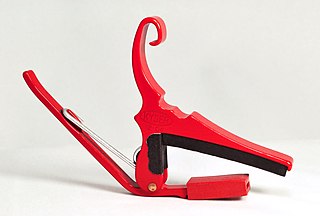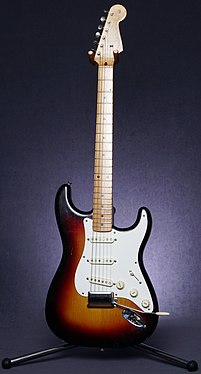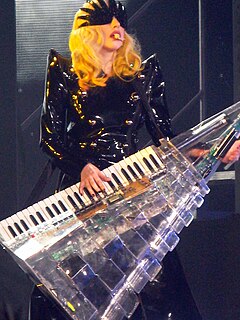
An electric guitar is a guitar that uses one or more pickups to convert the vibration of its strings into electrical signals. The vibration occurs when a guitar player strums, plucks, fingerpicks, slaps or taps the strings. The pickup generally uses electromagnetic induction to create this signal, which being relatively weak is fed into a guitar amplifier before being sent to the speaker(s), which converts it into audible sound.

The guitar is a fretted musical instrument that usually has six strings. It is typically played with both hands by strumming or plucking the strings with either a guitar pick or the finger(s)/fingernails of one hand, while simultaneously fretting with the fingers of the other hand. The sound of the vibrating strings is projected either acoustically, by means of the hollow chamber of the guitar, or through an electrical amplifier and a speaker.

String instruments, stringed instruments, or chordophones are musical instruments that produce sound from vibrating strings when the performer plays or sounds the strings in some manner.

A capo is a device a musician uses on the neck of a stringed instrument to transpose and shorten the playable length of the strings—hence raising the pitch. It is a common tool for players of guitars, mandolins, mandolas, banjos, ukuleles and bouzoukis. The word derives from the Italian capotasto, which means the nut of a stringed instrument. The earliest known use of capotasto is by Giovanni Battista Doni who, in his Annotazioni of 1640, uses it to describe the nut of a viola da gamba. The first patented capo was designed by James Ashborn of Wolcottville, Connecticut.

An electronic keyboard or digital keyboard is an electronic musical instrument, an electronic or digital derivative of keyboard instruments. Broadly speaking, the term electronic keyboard or just a keyboard can refer to any type of digital or electronic keyboard instrument. These include synthesizers, digital pianos, stage pianos, electronic organs and digital audio workstations. However, an electronic keyboard is more specifically a synthesizer with a built-in low-wattage power amplifier and small loudspeakers.

The lap steel guitar is a type of steel guitar which is typically played with the instrument in a horizontal position on the performer's lap or otherwise supported. The performer changes pitch by pressing a metal or glass bar against the strings as opposed to a traditional guitar where the performer's fingertips press the strings against frets. The bar placed against the strings is called a "steel" or "tone bar".

The Fender Stratocaster is a model of electric guitar designed from 1952 into 1954 by Leo Fender, Bill Carson, George Fullerton, and completed by Freddie Tavares. The Fender Musical Instruments Corporation has continuously manufactured the Stratocaster from 1954 to the present. It is a double-cutaway guitar, with an extended top "horn" shape for balance like the Precision Bass guitar. Along with the Gibson Les Paul and Fender Telecaster, it is one of the most-often emulated electric guitar shapes. "Stratocaster" and "Strat" are trademark terms belonging to Fender. Guitars that duplicate the Stratocaster by other manufacturers are usually called S-Type or ST-type guitars.

The keytar is a relatively lightweight synthesizer that is supported by a strap around the neck and shoulders, similar to the way a guitar is supported by a strap. Keytars allow players a greater range of movement onstage, compared to conventional keyboards, which are placed on stationary stands or which are part of heavy, floor-mounted structures. The instrument has a musical keyboard for triggering musical notes and sounds. Various controls are placed on the instrument's "neck", including those for pitch bends, vibrato, portamento, and sustain.

A MIDI controller is any hardware or software that generates and transmits Musical Instrument Digital Interface (MIDI) data to MIDI-enabled devices, typically to trigger sounds and control parameters of an electronic music performance.

The electric upright bass (EUB) is an instrument that can perform the musical function of a double bass. It requires only a minimal or 'skeleton' body to produce sound because it uses a pickup and electronic amplifier and loudspeaker. Therefore, a large resonating structure is not required to project the sound into the air. This minimal body greatly reduces the bulk and weight of the instrument. EUBs must always be connected to an amplifier and speaker cabinet to produce an adequate audible sound. The EUB retains enough of the features of the double bass so that double bass players are able to perform on it.
Keyboard expression is the ability of a keyboard musical instrument to change tone or other qualities of the sound in response to velocity, pressure or other variations in how the performer depresses the keys of the musical keyboard. Expression types include:

The Fender Eric Clapton Stratocaster is the signature model electric guitar of English guitarist Eric Clapton. It was the first signature model guitar released by Fender.

A MIDI keyboard or controller keyboard is typically a piano-style electronic musical keyboard, often with other buttons, wheels and sliders, used for sending MIDI signals or commands over a USB or MIDI 5-pin cable to other musical devices or computers connected and operating on the same MIDI protocol. The basic MIDI keyboard does not produce sounds by itself, as it lacks an onboard sound engine. Instead, MIDI information on keys or buttons the performer has pressed is sent to a receiving device capable of creating sound through modeling synthesis, sample playback, or an analogue hardware instrument.
The Casio AZ-1 is a polyphonic MIDI keyboard in the form factor of a keytar. It has a distinctive white body with a long neck, with detailing in a pale blue. This instrument is designed to be played, with the aid of a shoulder strap, in an approximation of an electric guitar. As were many keytars, it was geared towards keyboardists who wanted greater freedom of movement during performances.
Finger vibrato is vibrato produced on a string instrument by cyclic hand movements. Despite the name, normally the entire hand moves, and sometimes the entire upper arm. It can also refer to vibrato on some woodwind instruments, achieved by lowering one or more fingers over one of the uncovered holes in a trill-like manner. This flattens the note periodically creating the vibrato.

The soft pedal is one of the standard pedals on a piano, generally placed leftmost among the pedals. On a grand piano this pedal shifts the whole action slightly to the right, so that the hammers which normally strike all three of the strings for a note strike only two of them. This softens the note and also modifies its tone quality. Tone quality is also affected by forcing the remaining two strings being struck to make contact with a part of the hammer felt which is not often hit ; this results in a duller sound, as opposed to the bright sound which is usually produced.
In classical guitar, the right hand is developed in such a way that it can sustain two, three, and four voice harmonies while also paying special attention to tone production. The index (i), middle (m), and ring (a) fingers are generally used to play the melody, while the thumb (p) accompanies in the bass register adding harmony, and produces a comparable texture and effect to that of the piano. The classical guitar is one of the very few solo polyphonic instruments, and is notoriously difficult to master.

A guitar synthesizer is any one of a number of musical instrument systems that allow a guitarist to access synthesizer capabilities.

A jammer is a new musical instrument characterized by at least one isomorphic keyboard, and thumb-operated and/or motion-sensing expressive controls. The instrument is designed to be fast to learn to play, very fast to play, and very expressive.

The Otamatone is an electronic musical synthesizer. It was developed in Japan in 1998 by the CUBE toy company and the Maywa Denki design firm, led by the brothers Masamichi and Nobumichi Tosa.

















